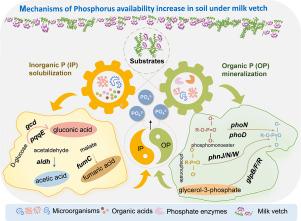长期绿肥通过改变微生物功能基因和酶活性提高土壤磷有效性
IF 5
2区 农林科学
Q1 SOIL SCIENCE
引用次数: 0
摘要
黄芪(Astragalus sinicus L.)有机肥替代矿质肥对土壤磷素动态和有效性影响较大。黄豆杉有机施肥如何影响土壤磷循环功能基因的具体作用,以及改变磷周转的机制尚不清楚。土壤样本取自一项为期10年的田间试验,其中包括矿物肥料和部分用豇豆代替矿物肥料,以及未施肥的对照。宏基因组测定的土壤磷循环功能基因与磷酸酶活性和不同效度的磷组分有关。与矿物肥相比,紫云英替代降低了土壤全磷和NaHCO3-OP(分别为8%和65%),但保持了相似的有效磷和高磷酸酶活性,表明紫云英替代对土壤磷的净增溶/矿化发生了响应。Proteobacteria是参与土壤磷循环最多的菌门,其次是Chloroflexi、Acidobacteria、Actinobacteria、Nitrospirae、Verrucomicrobia和gemmatimonadees。p循环功能基因群落的变化与土壤全氮和有机碳与全磷的比值关系更密切。p循环功能基因的相对丰度使PQQ-GDH (gcd, pqqE)、延胡索酸(fumC)、乙酸(aldh)、酸性磷酸酶(phoN)、碱性磷酸酶(phoD)的产量、有机膦酸盐(phnJ、phnN和phnW)的分解代谢和甘油-3-磷酸(glpB、glpF和glpR)的分化提高了4% ~ 80%。磷酸酶活性随着黄豆杉取代的增加而增加,这是由于相关基因和基因寄存群落的丰度增加(尤其是氯氟草)。phoN基因是有机磷矿化和速效磷的关键预测因子。总体而言,紫云英替代增加了磷获取酶的活性,促进了磷循环中功能基因的参与,从而刺激了磷的生物利用度。这些结果强调了黄豆杉替代与磷循环功能基因之间的联系,这也对未来在农业系统中通过黄豆杉替代来抵消对磷矿肥的需求具有重要意义。本文章由计算机程序翻译,如有差异,请以英文原文为准。

Long-term green manuring increases phosphorus availability in soil by modifying microbial functional genes and enzyme activities
Substitution of mineral fertilizers with milk vetch (Astragalus sinicus L.) organic fertilization strongly influences the dynamics and availability of phosphorus (P) in soil. How milk vetch organic fertilization affects the specific roles of P cycling functional genes in soil and, in turn, the mechanisms of altered P turnover remain unclear. Soil samples were taken from a 10-year field experiment that included mineral fertilizer and partial substitution of mineral fertilizer with milk vetch, together with an unfertilized control. The P-cycling functional genes in soil determined by metagenomics were related to phosphatase enzyme activities and P fractions with various availability. Milk vetch substitution decreased soil total P and NaHCO3-OP (8 and 65 %) but maintain similar available P and high phosphatase activities compared with mineral fertilizer, indicating a net solubilization/mineralization of soil P occurring in response to milk vetch substitution. The Proteobacteria, followed by Chloroflexi, Acidobacteria, Actinobacteria, Nitrospirae, Verrucomicrobia, and Gemmatimonadetes were the most abundant bacteria phyla involved in soil P-cycling. Shifts in P-cycling functional gene community were more related to soil total N and the ratio of SOC to total P. The relative abundance of P-cycling functional genes, increased the production of PQQ-GDH (gcd, pqqE), fumaric acid (fumC), acetic acid (aldh), acid phosphatase (phoN), alkaline phosphatase (phoD), the catabolism of organophosphonates (phnJ, phnN, and phnW) and the dissimilation of glycerol-3-phosphate (glpB, glpF, and glpR) by 4 %–80 %. Phosphatase activities increased with milk vetch substitution, because of raised abundance of related genes and gene-harboring communities (especially Chloroflexi). The phoN gene was the key predictor of organic P mineralization and thus available P. Overall, milk vetch substitution increased the P-acquiring enzyme activities and boosted the involvement of the functional genes in P cycling, which in turn stimulated P bioavailability. These results highlight the connections between milk vetch substitution and P cycling functional genes, which also have implications for offsetting the future demand for P mineral fertilizer by milk vetch substitution in agricultural systems.
求助全文
通过发布文献求助,成功后即可免费获取论文全文。
去求助
来源期刊

Applied Soil Ecology
农林科学-土壤科学
CiteScore
9.70
自引率
4.20%
发文量
363
审稿时长
5.3 months
期刊介绍:
Applied Soil Ecology addresses the role of soil organisms and their interactions in relation to: sustainability and productivity, nutrient cycling and other soil processes, the maintenance of soil functions, the impact of human activities on soil ecosystems and bio(techno)logical control of soil-inhabiting pests, diseases and weeds.
 求助内容:
求助内容: 应助结果提醒方式:
应助结果提醒方式:


